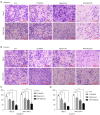Dual inhibition of autophagy and PI3K/mTOR pathway as a potential therapeutic strategy against laryngeal squamous cell carcinoma
- PMID: 35706786
- PMCID: PMC9189222
- DOI: 10.21037/tcr-21-2325
Dual inhibition of autophagy and PI3K/mTOR pathway as a potential therapeutic strategy against laryngeal squamous cell carcinoma
Abstract
Background: New and effective chemotherapy or targeted therapy strategies are needed against laryngeal squamous cell carcinoma (LSCC). We aimed to explore the antitumor effect of dual PI3K/mTOR inhibitor combined with autophagy suppression on LSCC and its underlying mechanism.
Methods: Hep-2 and AMC-HN-8 cell lines were treated with the Akt inhibitor LY294002, mTOR inhibitor rapamycin, and dual inhibitor NVP-BEZ235 separately. The biological characteristics of in vitro proliferation, cell cycle, apoptosis, migration, invasion, and autophagy were analyzed, and the expression levels of PI3K/Akt/mTOR pathway-related proteins were also measured. The in vivo effects of NVP-BEZ235 combined with inhibition of autophagy using pharmacological inhibitor was further assessed.
Results: Compared with Akt or mTOR inhibitor, NVP-BEZ235 had the most significant biological effects on LSCC cells. When combined with various autophagy inhibitors, along with siRNA against ATG7, NVP-BEZ235 showed a synergic antitumor effect in LSCC through increasing cell apoptosis and death both in vitro and vivo.
Conclusions: NVP-BEZ235 exerted potent antitumor effects on LSCC, especially when combined with the autophagy inhibitor both in vitro and vivo, providing convincing experimental data for new molecular targeted therapy for LSCC.
Keywords: Laryngeal squamous cell carcinoma (LSCC); PI3K/mTOR inhibitors; autophagy.
2022 Translational Cancer Research. All rights reserved.
Conflict of interest statement
Conflicts of Interest: All authors have completed the ICMJE uniform disclosure form (available at https://tcr.amegroups.com/article/view/10.21037/tcr-21-2325/coif). The authors have no conflicts of interest to declare.
Figures







Similar articles
-
Inhibition of Autophagy Increases Proliferation Inhibition and Apoptosis Induced by the PI3K/mTOR Inhibitor NVP-BEZ235 in Breast Cancer Cells.Clin Lab. 2015;61(8):1043-51. doi: 10.7754/clin.lab.2015.150144. Clin Lab. 2015. PMID: 26427150
-
Dual PI3K/mTOR inhibitor NVP-BEZ235-induced apoptosis of hepatocellular carcinoma cell lines is enhanced by inhibitors of autophagy.Int J Mol Med. 2013 Jun;31(6):1449-56. doi: 10.3892/ijmm.2013.1351. Epub 2013 Apr 16. Int J Mol Med. 2013. PMID: 23588698
-
Autophagy inhibition enhances colorectal cancer apoptosis induced by dual phosphatidylinositol 3-kinase/mammalian target of rapamycin inhibitor NVP-BEZ235.Oncol Lett. 2016 Jul;12(1):102-106. doi: 10.3892/ol.2016.4590. Epub 2016 May 17. Oncol Lett. 2016. PMID: 27347108 Free PMC article.
-
Efficacy of the dual PI3K and mTOR inhibitor NVP-BEZ235 in combination with imatinib mesylate against chronic myelogenous leukemia cell lines.Drug Des Devel Ther. 2017 Apr 3;11:1115-1126. doi: 10.2147/DDDT.S132092. eCollection 2017. Drug Des Devel Ther. 2017. PMID: 28435223 Free PMC article.
-
Landscape of targeted therapies for lung squamous cell carcinoma.Front Oncol. 2024 Oct 31;14:1467898. doi: 10.3389/fonc.2024.1467898. eCollection 2024. Front Oncol. 2024. PMID: 39544292 Free PMC article. Review.
Cited by
-
Personalized Treatment Strategies via Integration of Gene Expression Biomarkers in Molecular Profiling of Laryngeal Cancer.J Pers Med. 2024 Oct 10;14(10):1048. doi: 10.3390/jpm14101048. J Pers Med. 2024. PMID: 39452555 Free PMC article. Review.
-
Recent Update and Drug Target in Molecular and Pharmacological Insights into Autophagy Modulation in Cancer Treatment and Future Progress.Cells. 2023 Jan 31;12(3):458. doi: 10.3390/cells12030458. Cells. 2023. PMID: 36766800 Free PMC article. Review.
-
NRSN2 promotes the malignant behavior of HPV-transfected laryngeal carcinoma cells through AMPK/ULK1 pathway mediated autophagy activation.Cancer Biol Ther. 2024 Dec 31;25(1):2334463. doi: 10.1080/15384047.2024.2334463. Epub 2024 Apr 3. Cancer Biol Ther. 2024. PMID: 38569536 Free PMC article.
-
A novel fumaric acid metabolism-related prognostic signature associated with prognosis and immune infiltration landscape in laryngeal squamous cell carcinoma.Transl Cancer Res. 2025 Jul 30;14(7):3991-4008. doi: 10.21037/tcr-2025-29. Epub 2025 Jul 25. Transl Cancer Res. 2025. PMID: 40792153 Free PMC article.
-
ERCC6L facilitates the progression of laryngeal squamous cell carcinoma by the binding of FOXM1 and KIF4A.Cell Death Discov. 2023 Feb 2;9(1):41. doi: 10.1038/s41420-023-01314-3. Cell Death Discov. 2023. PMID: 36726012 Free PMC article.
References
-
- National Comprehensive Cancer Network clinical practice guidelines in oncology, head and neck cancers, version 1.2021. Accessed: 11 March 2021. Available online: https://www.nccn.org/guidelines/patients
LinkOut - more resources
Full Text Sources
Miscellaneous
